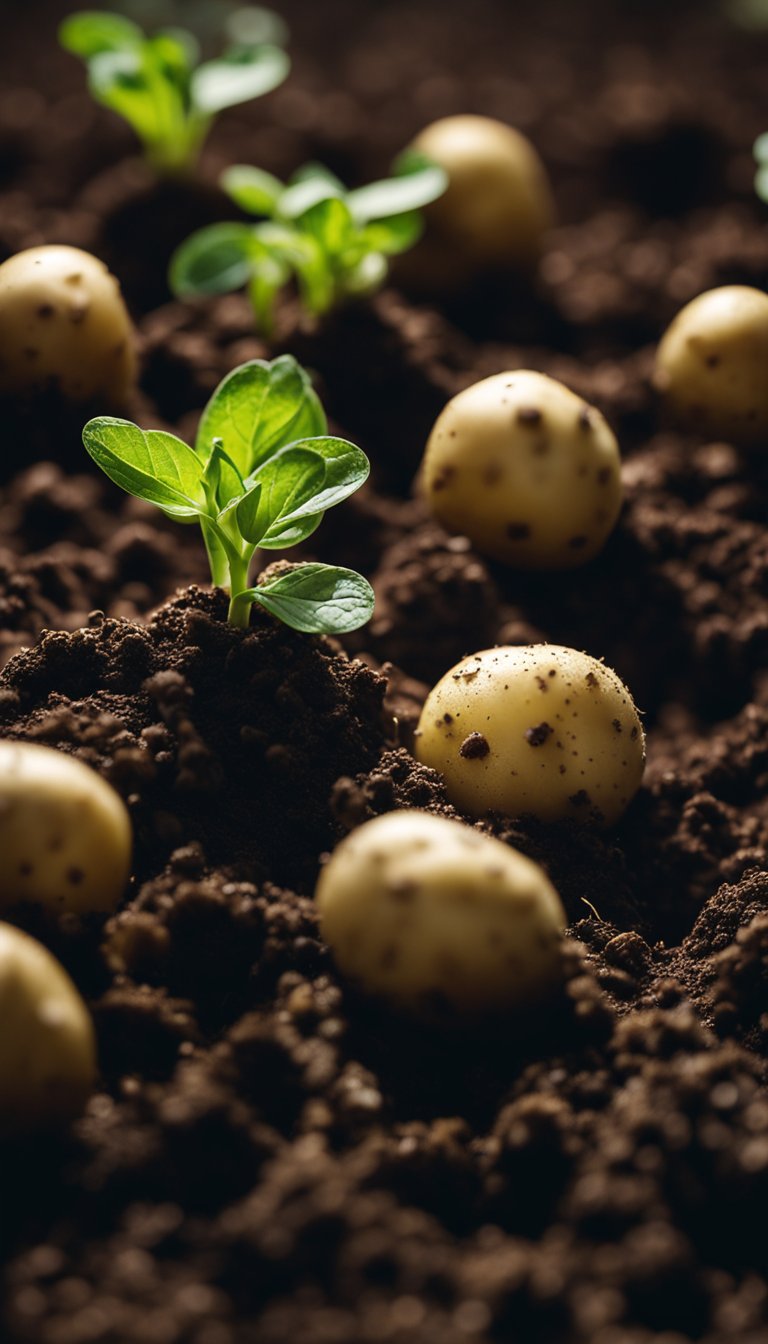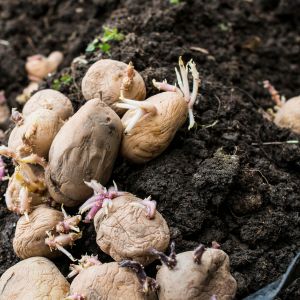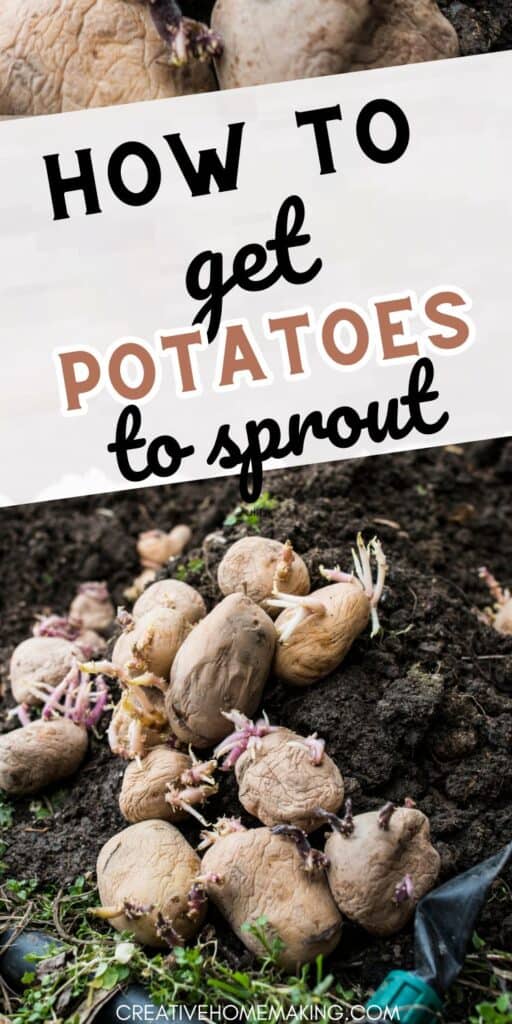Are you tired of buying potatoes that are already sprouted? Or maybe you want to grow your own potatoes but don’t know where to start? Sprouting potatoes is actually quite easy and can be done with just a few simple steps. In this article, we will guide you through the process of getting your potatoes to sprout.
This post may contain affiliate links.
First, it’s important to choose the right potatoes. Look for potatoes that are firm and free from any soft spots or blemishes. Potatoes that are too old or have been stored improperly may not sprout. Once you have your potatoes, store them in a cool, dark place until you’re ready to sprout them.
To encourage sprouting, you can use a technique called “chitting”. This involves placing your potatoes in a bright, cool place for a few weeks before planting. To chit your potatoes, simply place them in an egg carton or on a tray with the eyes facing up.
Keep them in a cool room with plenty of natural light, but away from direct sunlight. After a few weeks, you should start to see small sprouts emerging from the eyes of the potatoes.
Understanding Potato Sprouting
Potatoes are a staple food in many households, but have you ever wondered how they sprout? Understanding the biology of potato sprouts is important if you want to grow potatoes successfully.
In this section, we will discuss the biology of potato sprouts, the importance of chitting, and other factors that affect potato sprouting.
Related Article: Fall Planting: How to Successfully Plant Potatoes
The Biology of Potato Sprouts
Potato sprouts are the result of a process called dormancy. During this period, the potato is in a state of rest and does not grow. However, when the conditions are right, the potato will begin to sprout.
The sprouts emerge from the eyes of the potato, which are small dimples on the surface of the potato.
Related Article: Preserving and Storing Potatoes
It is important to note that sprouted potatoes contain solanine, a toxic compound that can cause illness if ingested in large amounts. Therefore, it is important to remove any sprouts or green spots before consuming potatoes.

Importance of Chitting
Chitting is the process of allowing potatoes to sprout before planting them. This process helps to ensure that the potato will grow properly and produce a healthy crop. To chit potatoes, simply place them in a cool, dry place with plenty of light. The sprouts will begin to emerge after a few weeks.
Chitting also helps to break the potato’s dormancy, allowing it to grow more quickly once it is planted. Additionally, chitting can help to reduce the risk of disease and pest infestations.
Related Article: Baked Potatoes on the Grill
Preparing Seed Potatoes for Sprouting
If you want to grow potatoes in your garden, you’ll need to start with seed potatoes. These are potatoes that have been specifically grown and selected for their ability to produce new plants. Here are some tips on how to prepare your seed potatoes for sprouting:
Selecting the Right Varieties
When choosing your seed potatoes, it’s important to select the right varieties. Look for high-quality seed potatoes that are disease-free and have a good sprouting potential. Some popular varieties include Yukon Gold, Russet, and Red Pontiac.
Cutting and Curing Seed Potatoes
Once you have your seed potatoes, you’ll need to cut them into pieces. Each piece should have at least one “eye” or sprout. You can cut the potatoes into pieces that are about 1-2 inches in size.
Before planting, it’s important to cure the seed potatoes. This involves storing them in a cool, dry place for a few days to allow the cut surfaces to callus over. This helps to prevent rot and disease.

Using Sprout Inhibitor
If you want to prevent your seed potatoes from sprouting too early, you can use a sprout inhibitor. These are chemicals that can be applied to the potatoes to slow down the sprouting process. However, it’s important to use these chemicals carefully and follow the instructions on the label.
To encourage sprouting, you can place your seed potatoes in an egg carton with the cut side facing up. Keep the carton in a warm, bright place and mist the potatoes with water every few days to keep them moist.
Related Article: Baked Potatoes for a Crowd
Creating the Ideal Environment
To get potatoes to sprout, you need to create the perfect environment for them to thrive. Here are some tips to help you create the ideal environment:
Temperature and Humidity Control
Potatoes need to be kept in a cool, dark place with a temperature between 45-50°F (7-10°C). This will help prevent them from sprouting too quickly or rotting.
If the temperature is too high, the potatoes will sprout too quickly and become unusable. If the temperature is too low, the potatoes will not sprout at all.
In addition to temperature control, humidity is also important. Potatoes need to be stored in a place with high humidity to prevent them from drying out.
You can achieve this by placing the potatoes in a perforated plastic bag or in a container with a lid that has small holes for ventilation.
Potato 10 Gallon Grow Bag Garden Vegetable Non-Woven Fabric Planters Growing Bag with Handles
Light Exposure and Protection
Potatoes need to be kept in a dark location to prevent them from sprouting prematurely. Exposure to light can trigger the sprouting process, which can cause the potatoes to become unusable.
If you need to store your potatoes in an area with some light exposure, make sure to protect them with a cover or cloth. This will help to block out any light and keep the potatoes in a dark environment.
Remember, the key to creating the ideal environment for your potatoes to sprout is to control the temperature and humidity, and to keep them in a dark location. By following these tips, you can ensure that your potatoes will sprout at the right time and be ready to use when you need them.
Planting and Growing Techniques
Growing potatoes can be a fun and rewarding experience. Whether you have a large garden or just a small patio, potatoes can be grown in a variety of ways. Here are some planting and growing techniques to help you get started.
Hilling and Mulching
Hilling is a technique used to encourage the growth of potatoes. It involves piling soil around the base of the plant as it grows, which helps to protect the developing tubers from sunlight and encourages the plant to produce more tubers.
Mulching is another technique that can be used to protect the tubers from sunlight and to help retain moisture in the soil.
To hill your potatoes, start by planting them in a trench about 4-6 inches deep. As the plants grow, gradually pile soil around the base of the plant until you have created a small hill.
You can also add a layer of mulch on top of the soil to help retain moisture and keep the soil cool. Good mulch options include straw, leaves, or grass clippings.
Watering and Drainage
Potatoes need consistent moisture to grow properly, but they also require good drainage. Too much water can lead to rot, while too little water can cause the tubers to become misshapen.
To ensure that your potatoes get the right amount of water, water them deeply once a week, or more often if the weather is particularly hot and dry. Make sure that the soil is well-draining, and avoid planting potatoes in areas that are prone to flooding.
Container and Raised Bed Options
If you don’t have a lot of space or if you want to grow potatoes in a more controlled environment, you can use containers or raised beds.
Containers can be anything from grow bags to old buckets, as long as they have good drainage and are at least 12 inches deep. Fill the container with a good quality potting soil and plant your potatoes as usual.
Raised beds are another great option for growing potatoes. They provide good drainage and allow you to control the soil quality more easily.
To create a raised bed, simply build a frame out of wood or other materials and fill it with soil. Plant your potatoes as usual, making sure to hill them as they grow.
Frequently Asked Questions
What’s the best way to encourage eyes to sprout on potatoes?
The best way to encourage eyes to sprout on potatoes is to store them in a cool, dark place for a few weeks. Make sure to keep them away from light and moisture, as this can cause them to rot. You can also place them in a paper bag or cardboard box to help keep them dry.
Can I use water to help my potatoes sprout?
Yes, you can use water to help your potatoes sprout. Simply place your potatoes in a shallow dish or bowl and cover them with water. Make sure to change the water every few days to keep it fresh. After a few weeks, you should start to see sprouts forming.
Is it safe to eat potatoes that have sprouted?
While it is safe to eat potatoes that have sprouted, it’s best to remove the sprouts before cooking. The sprouts contain solanine, which can be toxic in large amounts. If the potato has a lot of sprouts or they are very large, it’s best to discard it.
What should I know about planting sprouted potatoes during the colder months?
If you plan to plant sprouted potatoes during the colder months, make sure to wait until the soil has warmed up to at least 45°F (7°C). Plant them in well-draining soil and keep them watered. You can also cover them with a layer of straw or mulch to help keep them warm.
How can I quickly sprout a potato in a jar?
To quickly sprout a potato in a jar, cut the potato in half and place it in a jar with toothpicks holding it in place. Fill the jar with water until the bottom of the potato is submerged.
Place the jar in a warm, sunny location and change the water every few days. After a week or two, you should start to see sprouts forming.
What are the necessary conditions for potatoes to start sprouting?
Potatoes need to be stored in a cool, dark place with good air circulation to start sprouting. They also need to be kept dry, as moisture can cause them to rot. Once the potatoes start to sprout, they need to be exposed to light to help the sprouts grow.
Follow my gardening board on Pinterest.





